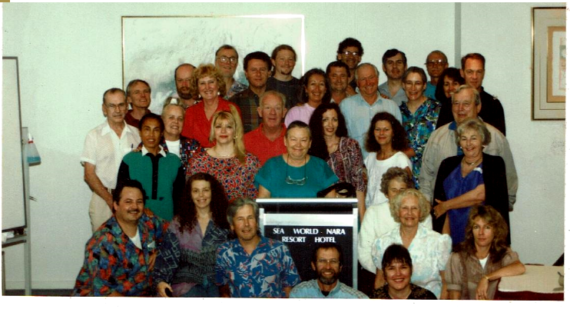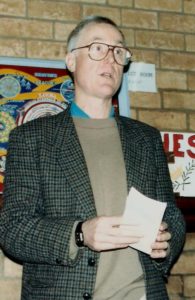Conference report
From 606 – 1993 Nov/Dec

The 1993 URANTIA Book Readers’ Conference at the Gold Coast is over. As Neil has mentioned elsewhere in this special conference issue of Six-O-Six, it was a terrific gathering for all concerned. The theme ‘Welcome to the Shores of Paradise’ was defined in more practical terms as “sharing insights on how we envisage we can spiritually grow [by] better communication with the divine monitor that dwells within the human mind”.
Neil provided an excellent opportunity for individual readers to give short personal accounts of how they strive to do this, as he explains in the ‘On Reflection’ section in this issue. He also afforded a group-oriented opportunity for all participants to put in their views, with group leaders reporting back to the full gathering their group’s conclusions.
Each of the three days kicked off with a more formal presentation of ideas and concepts spurred by the theme. Neil on the first morning spoke about the concept of pattern on different levels as a conceptual framework to view our Paradise ascent.
On Sunday morning, Ann Bendall gave a presentation on ego, and on the final morning,

Ken Glasziou gave a summary of how the Master himself refined his contact with his thought adjuster (not a bad role model, eh?) The two last talks are covered elsewhere in this edition.
How to become more Jesus-like

I want to take the concept one step further, and, as is my wont, a purely practical step.
More effective communication with our thought adjusters equates to more effective striving to do the will of the Father. How did Jesus do this, in practical terms?
“There was so little of the professional, the well planned, or the pre-meditated in the Master’s earthly ministry. He dispensed health and scattered happiness naturally and gracefully as he journeyed through life. It was literally true, ‘He went about doing good”‘. [Paper 171:7.9, page 18754]
One of his assets, however, was that he was so tuned into “ … what was in the heart and mind of man … expert in the comprehension of human need, clever in detecting human longings”.
People sensed this at a glance and were drawn to him and often asked him questions which gave him the starting point to reveal his truth. We don’t have such an asset, or at least I don’t going by my own personal experience. So if we assume we won’t be bombarded with questions, perhaps one way of getting in touch with our fellow child of God is to learn how to take the first step.
How did Jesus do it? I can only find four times that the Master encountered any of his children and had to step in:
The young man who was afraid (1437); the wife basher, while embarking at Tarentum (1470); Flavius, the art-conscious Greek Jew (1600); and the woman of Sychar – at Jacob’s well.
I’ve mixed clues for these four encounters together with my own experience to come up with some thoughts on a suggested ‘how-to’ guide for us.
Ask questions
Cultivate your genuine interest in the person by getting to where they are at. Ask questions that are open-ended. That means ones that invite an opinion or explanation, rather than a yes/no answer. Questions starting with ‘how?’, ‘why?’, ‘in what way?’ are better than ‘do you?’ or ‘is it?’ questions. Statements like ‘tell me more about..’ : achieve the same effect as an open-ended question.
Keep trying. Even the Master’s opening gambit with the young man who was afraid, in effect asking if he could help the lad, didn’t work. Look at Jesus’ second attempt:
“I understand you come up to these hills to get away from folks; so, of course, you do not want to talk with me, but I would like to know whether you are familiar with these hills; do you know the direction of these trails?” [Paper 130:6.2, page 1437.2]
I guess it’s hard to communicate with someone unless you get them talking!
Listen
To ask the right questions, we have to be good listeners. There are two types of listening – passive and active. Passive is like being a sponge where the communication is essentially one way. Active listening also involves asking questions based on what has just been said to either reinforce or enlarge your understanding, of where they’re at rather than where you want them to be. Jesus was far more interested in Flavius’s soul than his art collection, and yet…
… Flavius was agreeably surprised when Jesus entered the home that, instead of [Jesus] rebuking him for having these supposedly idolatrous objects scattered around the house, he manifested great interest in the entire collection and asked many appreciative questions about each object as Flavius escorted him from room to room, showing him some of his favourite statues. [Paper 142:4.1, page 1600.2]
And what an opening line with the woman at Jacob’s well- “Give me a drink”. She was a Samaritan and Jews didn’t converse with Samaritans, let alone men speaking to women at wells. He knew this would get her going and it did. He got there in four words.
While embarking at Tarentum, his first question to the enraged man beating his wife was in the vein of damage control (“My friend, may I speak with you in private for a moment?”) He then asks three more questions, although the book doesn’t say what the man’s answers were to the questions.
Build/embellish
Jesus made extensive use of metaphor and analogy and in particular, when used in parables. With the young man, he used metaphors about “the service trails and happiness highways”; with the woman at the well in terms of the metaphor of well water versus spiritual water. (See pages 1688-1694 for an excellent summary of the use of parables.)
In his six months Rome sojourn with the thirty-two religious leaders …
… never once did he [Jesus] attack their errors or even mention the flaws in their teachings In each case he would select the troth in what they taught and then proceed so to embellish and illuminate this truth in their minds so that in a very short time this enhancement of the truth effectively crowded out the associated error … [Paper 132:0.4, page 1456.0]
Presentations:
Ken Glasziou – What Jesus Did
Ann C. Bendall – Ego

